I’ve discussed the issue of inserting a predicted FVC into the predicted lung volumes several times now. At the risk of beating this issue to death I’d like to put to rest the notion that an FVC and an SVC are the same thing.
A Forced Vital Capacity (FVC) maneuver is designed to measure the maximum expiratory flow rates, in particular the expired volume in 1 second (FEV1). It has long been recognized that the effort involved in the FVC maneuver can cause early airway closure, even in individuals with normal lungs, and that for this reason the vital capacity can be underestimated due to gas trapping. This effect is usually magnified with increasing age and in individuals with obstructive lung disease.
A Slow Vital Capacity (SVC) maneuver is designed to measure the lung volume subdivisions Inspiratory Capacity (IC) and Expiratory Reserve Volume (ERV), and to maximize the measured volume of the vital capacity. Due to the more relaxed nature of the SVC maneuver there is significantly less airway closure and for this reason the SVC volume is usually larger than the FVC, again even in individuals with normal lungs.
Comparing individual reference equations can be difficult but in general the reference equations for SVC and FVC agree with this. Taking the available SVC and FVC reference equations (unfortunately limited to Caucasian because there are almost no SVC equations for other ethnicities) it is apparent that the average predicted SVC is larger than the average predicted FVC, and that the magnitude of this difference increases with age:
and that this applies to both genders:
This is also true when the predicted SVC and FVC come from the same population which is the case for references [C] and [H]:
That’s it. An SVC and an FVC are not the same thing. A predicted FVC can of course be larger than a predicted SVC but that is due to the selection of specific reference equations and does not reflect the general relationship between SVC and FVC.
I promise that as long as everybody stops thinking that a predicted FVC is somehow “better” than a predicted SVC I won’t bring this subject up again. Is it a deal?
Predicted SVC was either calculated directly or by subtracting the predicted RV from the predicted TLC. (Note: ht = height in cm).
| Male | Reference | Formula |
| SVC | [A] | (0.073*ht)-(0.021*age)-6.866 |
| [C] | -5.897+(0.069*ht)-(0.023*age) | |
| [H] | -4.69-(0.025*age)+(6.44*(ht/100)) |
| Male | Reference | TLC Equation | RV Equation |
| [B] | (0.0795*ht)+(0.0032*age)-7.333 | (0.0216*ht)+(0.0207*age)-2.84 | |
| [K] | (0.118*ht)-13.23 | (0.0197*ht)+(0.0141*age)-2.08 | |
| [M] | (7.956*(ht/100))-6.948 | (3.38*(ht/100))+(0.02*age)-(0.014*wt)-3.927 | |
| [N] | (7.99*ht*0.01)-7.08 | (0.0131*ht)+(0.022*age)-1.23 |
| Female | Reference | Equation |
| SVC | [A] | (0.049*ht)-(0.023*age)-3.409 |
| [C] | -3.597+(0.05*ht)-(0.021*age) | |
| [H] | -5.49-(0.025*age)+(6.44*(ht/100)) |
| Female | Reference | TLC Equation | RV Equation |
| [B] | (0.059*ht)-4.537 | (0.0197*ht)+(0.0201*age)-2.421 | |
| [K] | (-0.0094*age)+(0.0629*ht)-4.48 | (0.0259*ht)+(0.0091*age)-3.15 | |
| [M] | (7.107*(ht/100))-6.435 | (2.548*(ht/100))+(0.017*age)-3.387 | |
| [N] | (6.6*ht*0.01)-5.79 | (0.0181*ht)+(0.016*age)-2 |
| Male | Reference | Equation |
| FVC | [D] | -0.1933+(0.00064*age)-(0.000269*age^2)+(0.00018642*ht^2) |
| [C] | -5.473+(0.067*ht)-(0.025*age) | |
| [E] | -6.142-(0.0281*age)+(7*(ht/100)) | |
| [F] | -8.7818+(0.0844*ht)-(0.0298*age) | |
| [G] | EXP(-10.258+2.28*LN(ht)+(0.006767*age)-(0.000124*age^2)) | |
| [H] | -5.22-(age*0.03)+(6.73*(ht/100)) | |
| [I] | (0.148*(ht/2.54))-(0.025*age)-4.241 | |
| [J] | (0.138*(ht/2.54))-(0.027*age)-3.445 | |
| [L] | (0.0517*ht)-(0.0207*age)-3.18 | |
| [M] | (6.628*(ht/100))-(0.028*age)-5.377 |
| Female | Reference | Equation |
| FVC | [D] | -0.356+(0.0187*age)-(0.000382*age^2)+(0.00014815*ht^2) |
| [C] | -3.335+(0.049*ht)-(0.024*age) | |
| [E] | -4.04-(0.0259*age)+(5.364*(ht/100)) | |
| [F] | -2.9001+(0.0427*ht)-(0.0174*age) | |
| [G] | EXP(-9.069+(2.013*LN(ht))+(0.00847*age)-(0.000155*age^2)) | |
| [H] | -5.87-(0.03*age)+(6.73*(ht/100)) | |
| [I] | (0.115*(ht/2.54))-(0.024*age)-2.852 | |
| [J] | (0.114*(ht/2.54))-(0.024*age)-2.795 | |
| [L] | (0.0441*ht)-(0.0189*age)-2.848 | |
| [M] | (4.321*(ht/100))-(0.023*age)-2.379 |
References:
[A] Cordero PJ, Morales P, Benlloch E, Miravet L, Cebrian J. Static Lung Volume: Reference values from a Latin population of Spanish descent. Respiration 1999; 66: 242-250.
[B] Crapo RO, Morris AH, Clayton PD, Nixon CR. Lung volume in healthy nonsmoking adults. Bull Eur Physiopathol Respir 1983; 18: 419-425
[C] Gutierrez C, et al. Reference values of pulmonary function tests for Canadian caucasians. Can Respir J 2004; 6: 414-424.
[D] Hankinson JL, Odencrantz JR, Fedan, KB. Spirometric reference values from a sample of the general U.S. Population. Amer J Resp Crit Care 1999; 159: 179-187
[E] Johannessen A, Lehmann S, Omenaas ER, Side GE, Bakke PS, Gulsvik A. Post-bronchodilator spirometry reference values in Adults and implications for disease mangement. Amer J Resp Crit Care Med 2006; 173(12): 1316-1325
[F] Knudson RJ, Lebowitz MD, Holberg CJ, Burrows B. Changes in the normal maximal expiratory flow volume curve with growth and aging. Am Rev Resp Dis 1983; 127: 725-734
[G] Kuster SP, Kuster D, Schindler C, Rochat MK, Braun J, Held L, Brandli O. Reference equations for lung function screening of healthy never-smoking adults aged 18-80 years. Eur Respir J 2008; 31: 860-868.
[H] Marsh S, Aldington S, Williams M, Weatherall M, Shirtcliffe P, McNaughton A, Pritchard A, Beaseley R. Complete reference ranges for pulmonary function tests from a single New Zealand population. New Zealand Med J 2006; 119: N1244.
[I] Morris JF, Koski A, Johnson LC. Spirometric standards for healthy nonsmoking adults. Am Rev Resp Dis 1971; 103: 57-67.
[J] Morris JF, Koski A, Temple WP, Claremont A, Thomas DR. Fifteen-year interval spirometric evaluation of the Oregon Predictive equations. Chest 1988; 93: 123-27
[K] Neder JA, Andreoni S, Castelo-Filho A, Nery LE. Reference values for lung function tests. I. Static Volume. Braz J Med Biol Res 1999; 32: 703-717
[L] Pereira CADC, Sato T, Rodrigues SC. New Reference Values for forced spirometry in white adults in Brazil. J Bras Pneumol 2007; 33: 397-406.
[M] Roberts CM, MacRae KD, Winning AJ, Adams L, Seed WA. Reference values and prediction equations for normal lung function in a non-smoking white urban population. Thorax 1991; 46: 643-650.
[N] Stocks J, Quanjer PH. Reference values for residual volume, function residual capacity and total lung capacity. Eur Respir J 1995; 8: 492-506.

PFT Blog by Richard Johnston is licensed under a Creative Commons Attribution-NonCommercial 4.0 International License


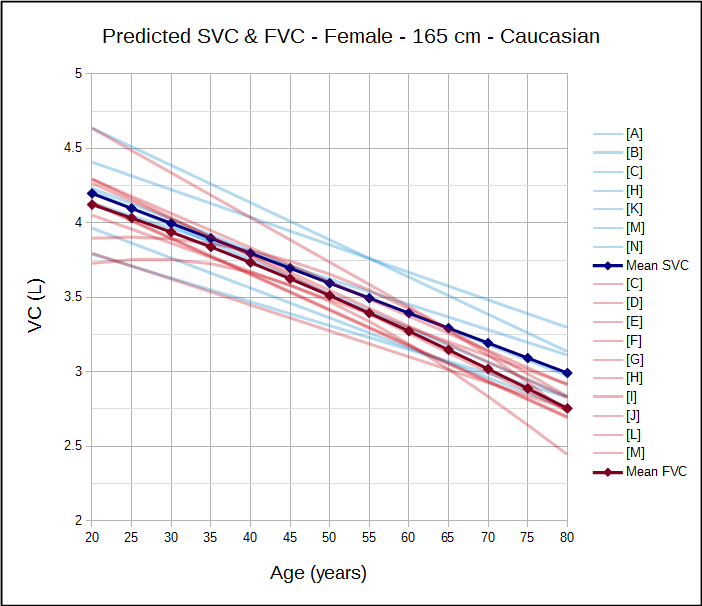
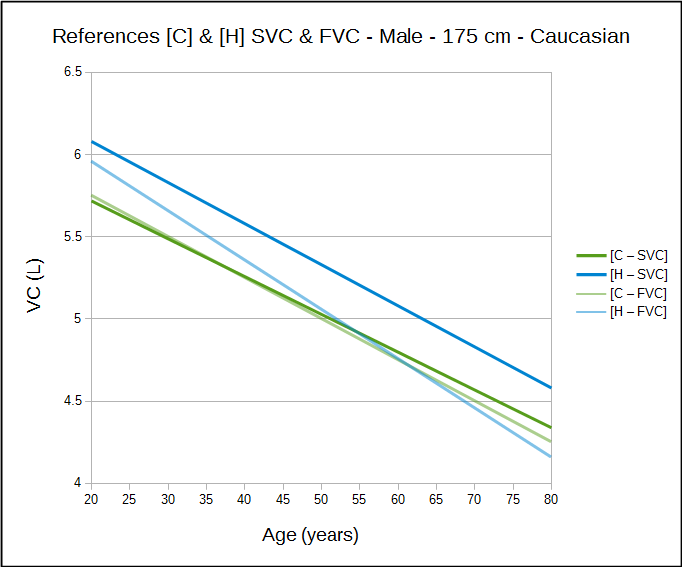
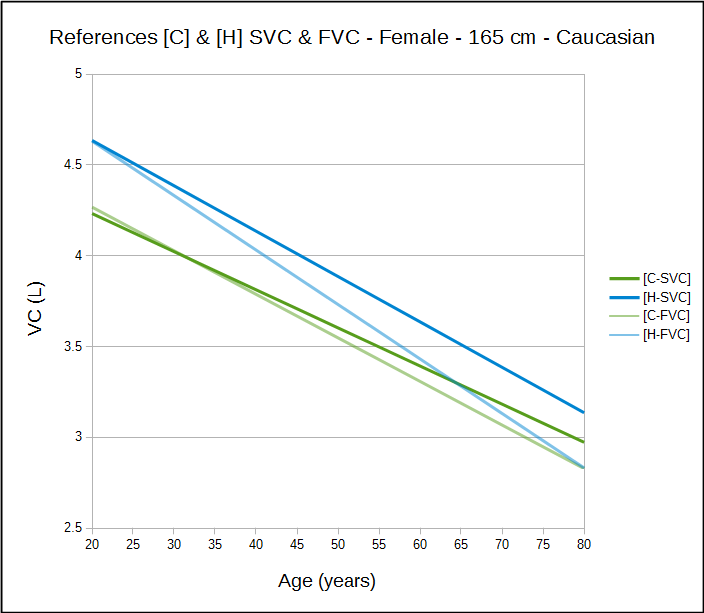
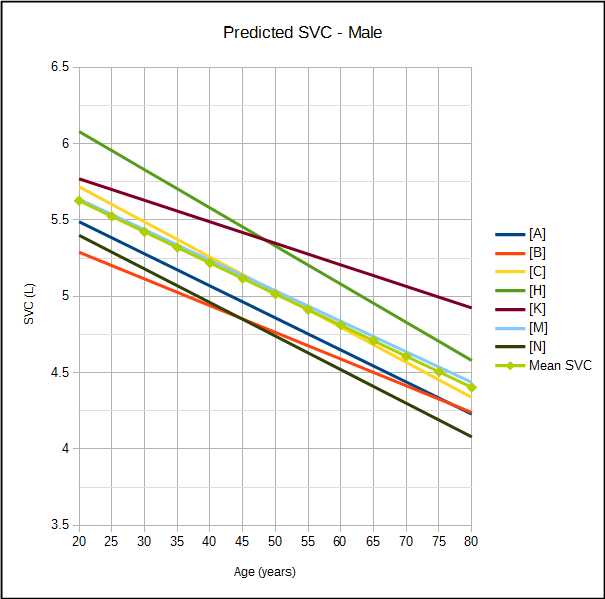
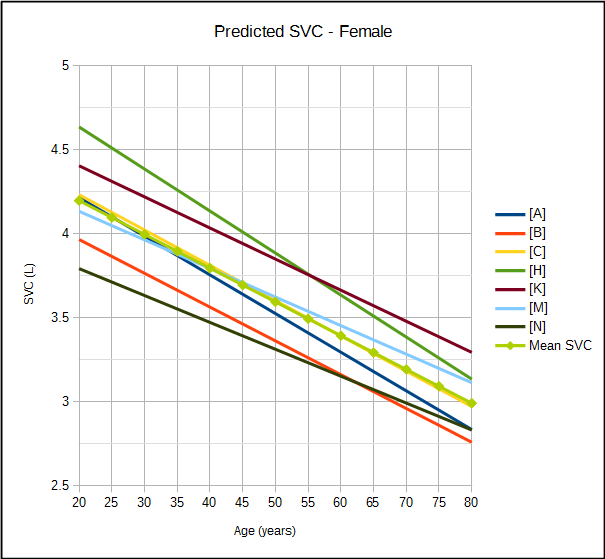
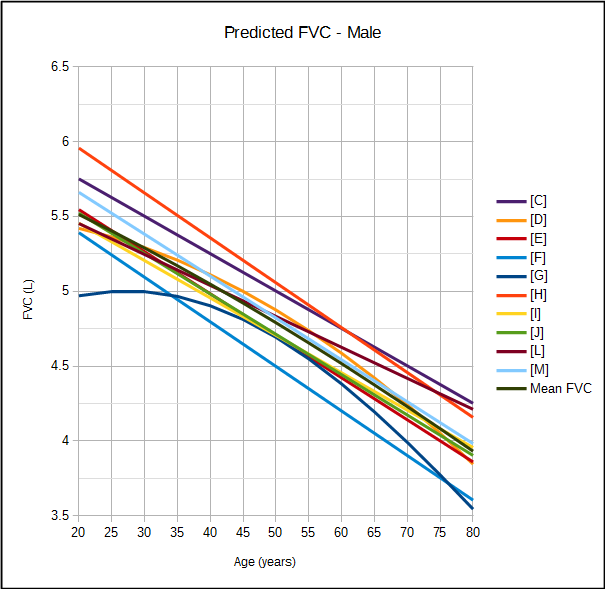
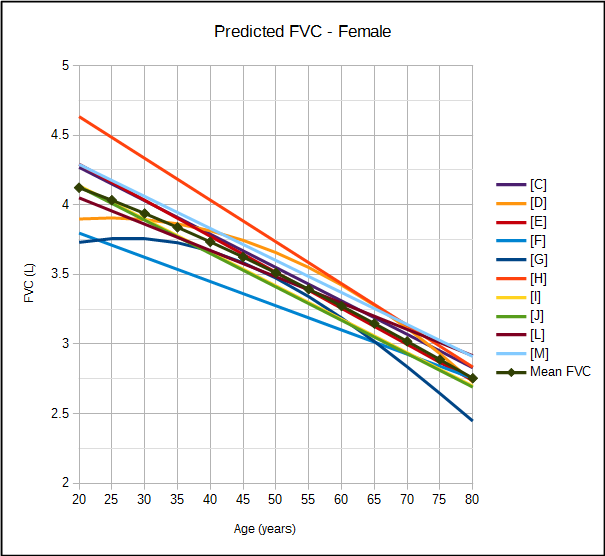
You might want to take a look at “Bronchodilator response in FVC is larger and more relevant than in FEV1 in severe airflow obstruction”, CHEST 2017; 151(5):1088-1098.